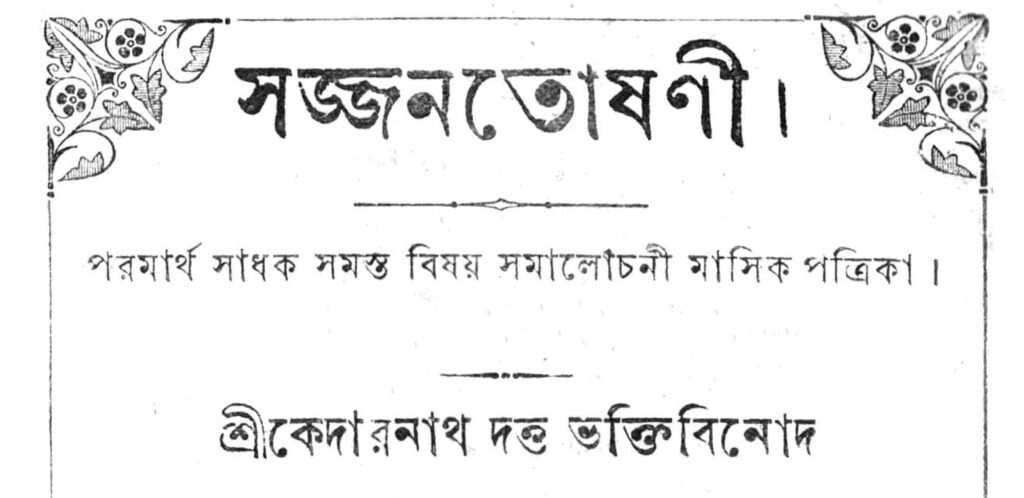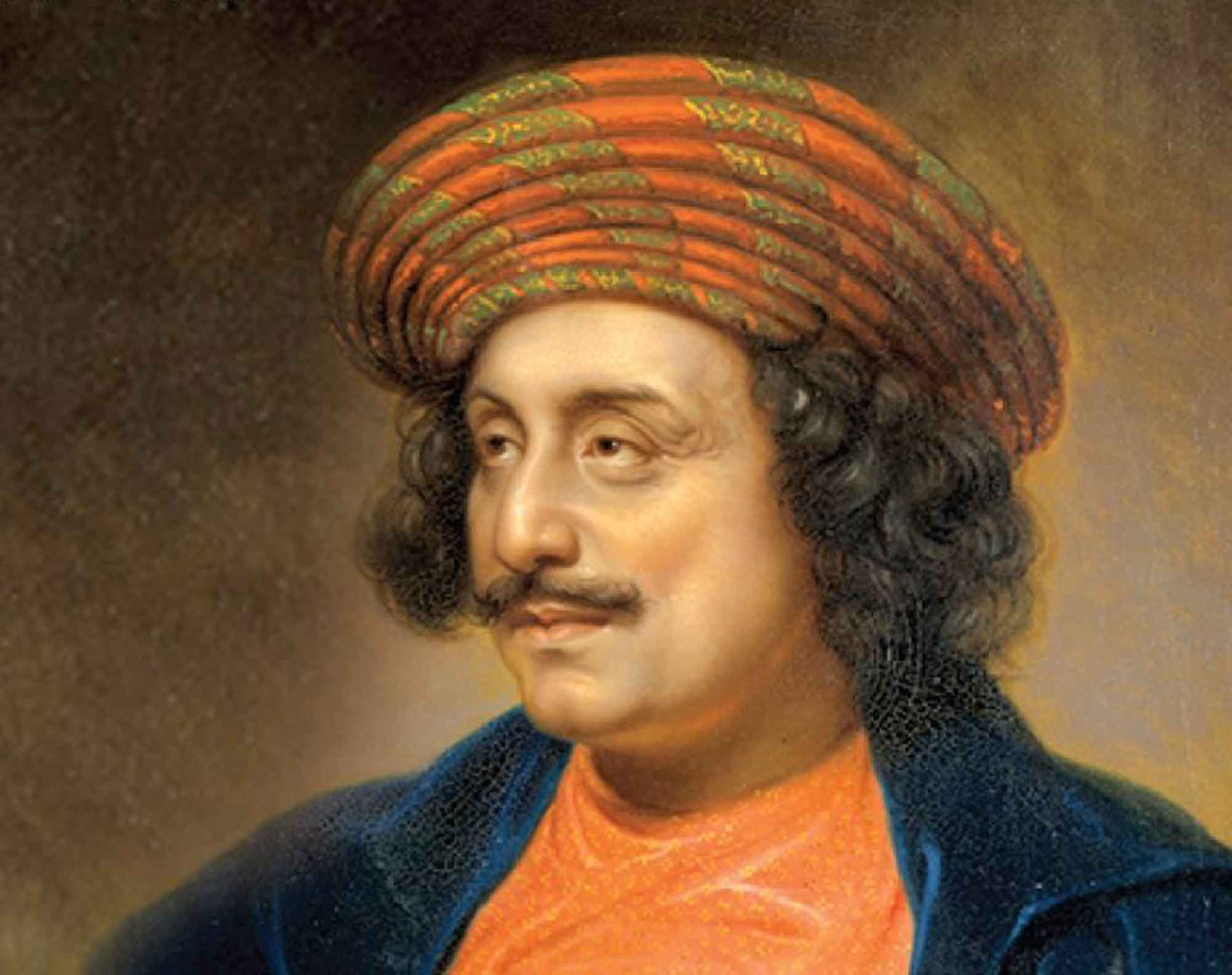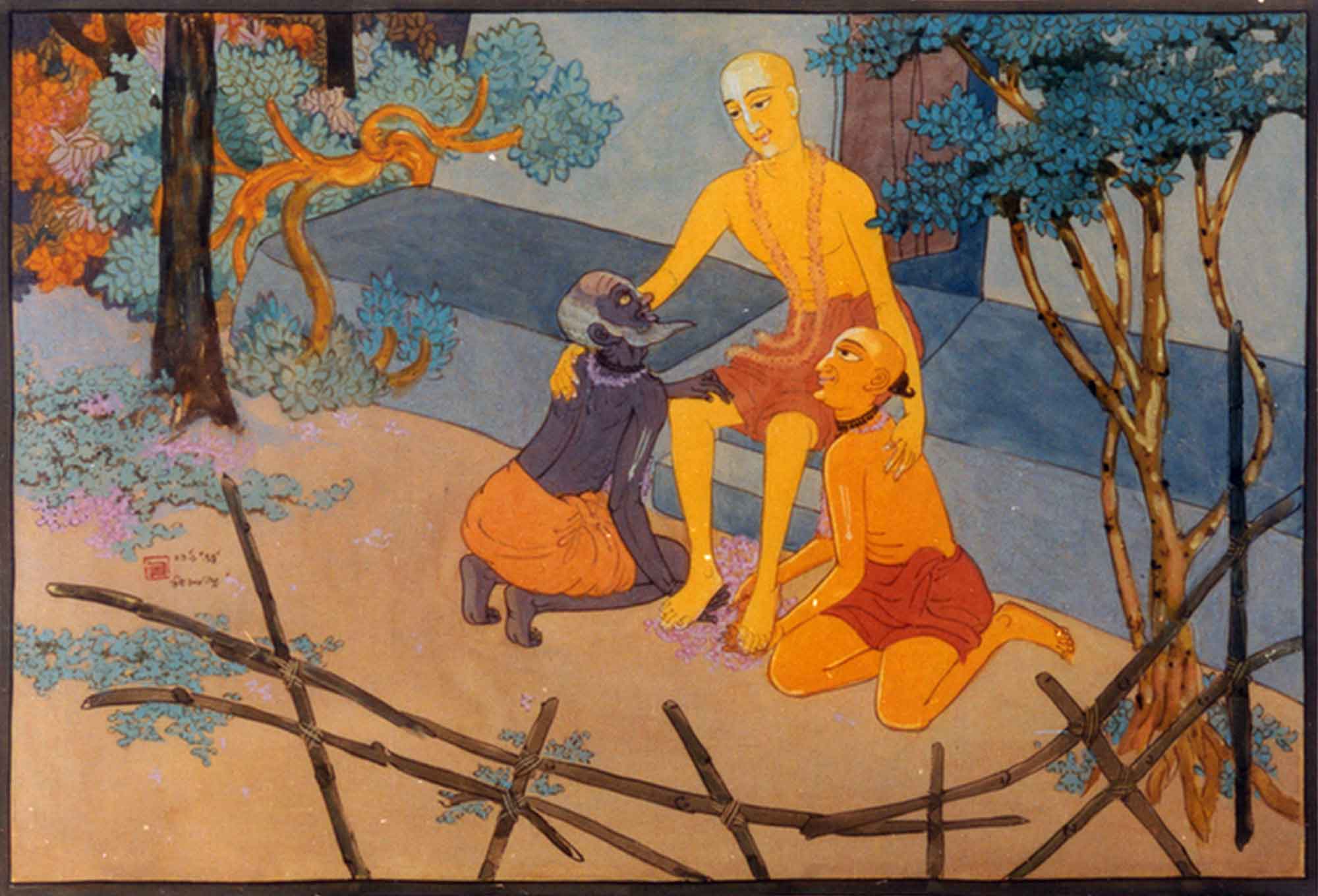Overview
Vastu Nirdeśa (Identifying the Supreme Object) was first published in Sajjana Toṣaṇī, Vol.2 issue 6 in 1885. This article is in answer to one gentleman inquiring about the position of Brahman, Paramātmā and Bhagavān, wishing to know the ‘Vedāntic siddhānta.’ In response, Bhaktivinoda Ṭhākura gives a detailed answer.
(translated by Swami B.V. Giri)
Śrī Amṛta-lāla Bose Mahāśaya has asked us a question. I am publishing that question along with the answer.
Question: Many people say that Brahman and Paramātmā are nirguṇa (formless), and Bhagavān is saguṇa (with form). And some people say that nirguṇa Brahman is the effulgence of Bhagavān, and Paramātmā is His manifestation. If you could kindly explain what is the Vedāntic siddhānta in your Sajjana Toṣaṇī we would be most obliged.
Answer: The questioner wants to know what is the Vedāntic siddhānta. The conclusion which conforms with Vedānta is called Vedāntic siddhānta. People have many doubts about what Vedānta is. The general belief is that the Vaiṣṇava doctrine and the Vedānta doctrine are different. Normally it is thought that Vaiṣṇavas follow the Bhāgavata and the Purāṇas. The Purāṇas are a different śāstra to the Vedānta. They have the idea in their minds that the opinion expressed by Śaṅkarācārya is Vedāntic philosophy. Such a belief is deeply rooted in a misunderstanding. We will take care to eliminate that misunderstanding first.
The Upaniṣads are said to be the highest division of the Vedas. There are many Upaniṣads. Amongst them Īśa, Kena, Kaṭha, Muṇḍaka, Māṇḍūkya, Śvetāśvatara, Chāndogya etc. have always been recognised as the ten upaniṣads. The statements of these Upaniṣads is called Vedānta. The word Vedānta is understood to mean the ultimate conclusion of the Vedas.
The statements of the Upaniṣads are basically intertwined. In the books of the Upaniṣads there is no conclusion on any subject based upon a divisional classification of that subject. Every statement is self-evident. It is difficult for a person with meagre intelligence to acquire the knowledge of Vedānta from the statements of the Upaniṣads.
Veda Vyāsa, the most merciful son of Satyavatī, divided all the Vedas for the benefit of the jīvas in order to simplify the explanation of the words of the Upaniṣads, he gathered all the statements of the Vedānta by constructing about five hundred and fifty sūtras and calling them the Vedānta-sūtra or Brahma-sūtra. After his disciples were unable to grasp the correct meaning of all of these sūtras, on the instruction of Nārada, he created the Pāramahaṁsya Saṁhitā in the form of the Śrīmad Bhāgavata Mahā-Purāṇa. The Śrīmad Bhāgavata composed by Vyāsa is a commentary on the Vedānta-sūtra. All the conclusions in the Śrīmad Bhāgavata are the true siddhānta of the Vedānta. Śrī Śrī Mahāprabhu has said that the meaning of the sūtras can only be found if the commentator is the sūtrakāra (composer of the sūtras) himself. Therefore the jīvas should accept the Bhāgavata commentary as the statements of the Vedānta itself.
Our questioner’s subject of inquiry is written in connection to the Bhāgavata being the natural commentary on the Vedānta-sūtra.
vadanti tat tattva-vidas tattvaṁ yaj jñānam advayam
brahmeti paramātmeti bhagavān iti śabdyate
(Śrīmad Bhāgavatam 1.2.11)
Advaya-jñāna (knowledge of the non-dual Absolute) is what those persons who are knowers of the truth call tattva (philosophical reality). That advaya-jñāna is known by the words Brahman, Paramātmā and Bhagavān. It is to be noted here that this advaya–tattva (non-dual Reality) is the ultimate resting place of all siddhānta. When Brahman, Paramātmā and Bhagāvan are defined as that advaya–tattva, then none amongst these manifestations are saguṇa. Brahman, Paramātmā and Bhagāvan are all nirguṇa.
What advaya-jñāna is must be analysed and ascertained. Many people think that only kevala–abhedavāda (the philosophy of exclusive monism) speaks about advaya-jñāna. This is not so. This is what kevala–abhedavāda teaches. In fact, the Veda-śāstra is svataḥ-siddha-jñāna (self-evident knowledge), therefore it does not favour any particular philosophy. The siddhānta of the Vedas is that by the acintya-śakti (potency of inconceivability) of the Supreme, both bheda (oneness) and abheda (difference) are eternally perfect. So much so, that this world and the jīvas are all simultaneously separate from the Supreme, but they are also one and the same. Dvaita and Advaita are simultaneously true, yet there is a difference between advaita-tattva which stems from matter and ātma-tattva (the principle of the ātmā). Also, there is a perpetual difference between the ātma-tattva of the jīva with its finite consciousness, and the Supreme. Anyone that understands this bhedābheda-tattva, will in due course not need to know anything else. When acintya-bhedābheda-tattva first manifests, this principle of advaya-jñāna is perfected. A jīva that naturally sees with this supreme principle, cannot see anything distinct from it. When he is subject to common vision, then he only sees difference. Matter manifests separately from consciousness as an eternally perfect principle. This is called dvaita-jñāna (knowledge of difference). There can be no knowledge of reality with dvaita-jñāna.
When knowledge of reality first arises, everything is seen in relation to Brahman. There is no more general vision. Material nature no longer seems to have a separate existence from Brahman. This is the state of advaya-brahma-jñānamaya (seeing everything as pervaded by the non-dual Brahman). While situated in brahma-jñāna, when the discerning jīva understand the ātmā to be separate, then advaya–jñāna becomes clearer and he perceives the form of the Paramātmā. Then he feels no connection with aparā-prākṛti (material nature). Then only, the jīva’s consciousness, in the form of parā-prākṛti (spiritual nature), becomes revealed. This is the second realisation of advaya-jñāna. When the reality of Paramātmā is established, then the discerning jīva sees the Supreme Consciousness as separate, and only then is advaya-tattva fully realised. At that point, the advaya-tattva is called Bhagavān. For the jīva, darśana of Bhagavān is the culmination of advaya-jñāna. Then, the Supreme Object is no longer compounded with parā and aparā-prākṛti, and it fully takes on its natural form. Thus, Bhagavān is the supreme manifestation of the advaya-tattva, He is parama-nirguṇa (Absolute and without any mundane qualities) and sacchidānanda (full of reality, cognizance and bliss). Those who state that Bhagavān is saguṇa and Brahman and Paramātmā are nirguṇa are definitely not skilled in discussions on Vedānta. They never attain the actual meaning of advaya-tattva.
If the respected reader examines the Third Canto, Second Chapter, 12th sūtra of the Brahma–sūtra, he will be able to understand our conclusion clearly. The sūtra is:
na bhedād iti cen na pratyekam atad-vacanāt
(“If someone objects claiming that all the forms are different, we say it is not so, because śruti explains that all the forms are non-different from the Supreme.” – Brahma-sūtra 3.2.12)
The kevala-advaita commentary has no proper conclusion about this sūtra. In discussing this sūtra in their commentaries, Rāmānuja and other great scholars have mentioned the śruti etc. and there is no space here to discuss all this here. Therefore we will be satisfied only in quoting the following text:
maṇir yathā vibhāgena nīla-pītādibhir yutaḥ
rūpa-bhedam avāpnoti dhyāna-bhedāt tathācyutaḥ
(Nārada Pañcarātra)
The inherent form of advaya-jñana is the principle of Acyuta – He alone is Bhagavān. According to the different perspectives of a jīva, He manifests Himself in various forms. When viewed from different angles, the same vaidūrya gem reveals different colors. Similarly, bhagavat-tattva is like a gem and according to the different qualifications of a jīva, He reveals Himself as Brahman, Paramātmā and Bhagavān. At this point, the question is, “How many qualifications does a jīva have?”
There are different types of qualification depending upon the intelligence and abilities of a jīva. According to material considerations, those qualifications are divided into three categories. The three qualifications are jñāna, yoga and bhakti. The person situated in jñānādhikāra (those who engage in jñāna) considers that experiencing Brahman is the best of all tattvas. The person situated in yogādhikāra sees the form of Paramātmā. The jīva situated in bhaktyādhikāra considers darśana of Bhagavān’s form to be the highest tattva and is satisfied with that.
Since the form of Bhagavān is His pūrṇa-svarūpa (complete and inherent form), it is the viśeṣya-tattva (substantive principle). Brahman and Paramātmā are both viśeṣaṇa (attributes) of the viśeṣya. When creation had not occurred, there was only Bhagavān and no one else. There was no Brahman. When the world was created then, sarvaṁ brahma mayaṁ jagat (‘everything in the world is Brahman’) – it is understood that Bhagavān appears in relation to the world in this way. There are two conceptions regarding Brahman. One is sarvaṁ khalvidaṁ brahma (‘indeed everything is Brahman’). The second idea especially does not take into consideration all created objects, or those things that are saguṇa (with qualities). Both views are in relation to the universe. Thus, Brahman is Bhagavān’s effulgence which pervades the universe. At this point it would be completely correct to say that Brahman is the effulgence of Bhagavān’s form. There can be no fault in saying that Paramātmā is an expansion of Bhagavān. The Bhagavad-gītā accepts the appearance of this expansion of Bhagavān with the creation of the jīva:
apareyam itas tv anyāṁ prakṛtiṁ viddhi me parām
jīva-bhūtāṁ mahā-bāho yayedaṁ dhāryate jagat
(“However, you should know that there is another nature, superior to this inferior nature. It is a conscious potency that consists of the living beings and maintains the universe.” – Bhagavad-gītā 7.5)
It seems that Amṛta Bābu will have no doubt. If there is any doubt, please write.













